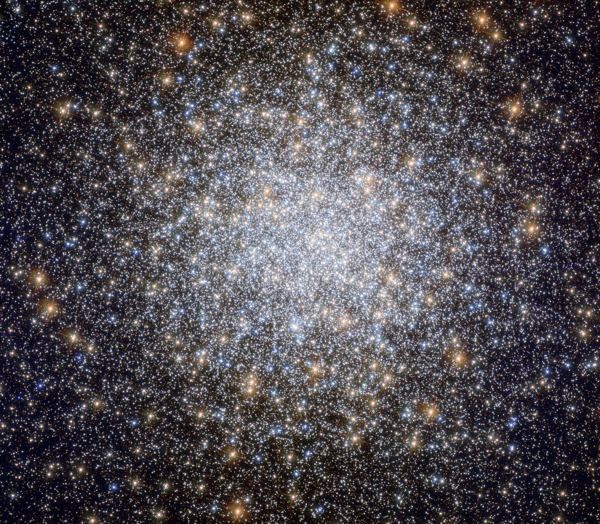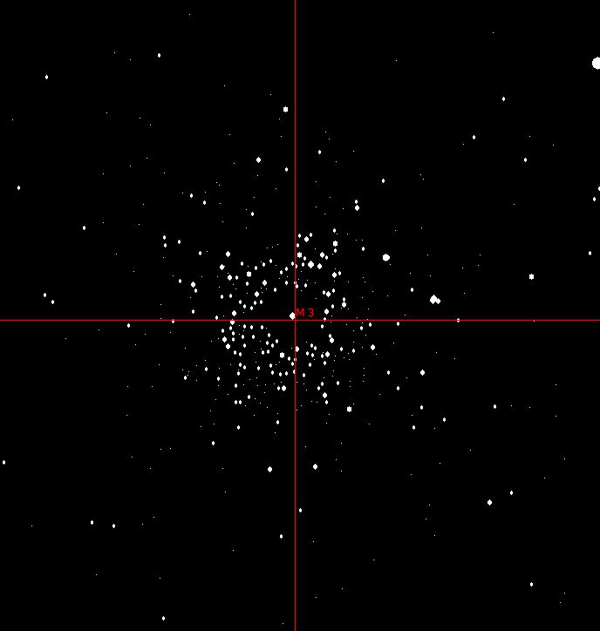The Large and the Small
April 2021 - Nebula and Cluster of the Month
Clusters and nebulae are still fairly thin on the ground – or in the sky – during April. This month, I’m going to present two objects to you, one I expect that you’ll be very familiar with – though I’m going to ask you to look at it again and do something – and one which you may not be so familiar with.
First to the familiar. Even with the massive domination of the sky by galaxies this month, one of the sky’s finest showpieces is also on show.

On 3rd May 1764, Charles Messier, using a small, poorly-made telescope, discovered an object in Canes Venatici, close to the border with Boötes. He described it as follows: Nebula without star, centre brilliant, gradually fading away; round. In a dark sky, visible in a telescope of one foot [focal length].
This object turned out to be the first in his famous list that he actually discovered himself. Known today as M3, it is a spectacular globular cluster, shining at a magnitude variously quoted as 5.9 or 6.3. It is easily visible in binoculars, even on a poor night.
The globular cluster lies at a distance of 32,000 light-years from us, and sits high above the galactic plane, relatively isolated. M3 is a very heavily-studied globular cluster, instrumental as it has been in the study of cluster ages and stellar evolution. It contains more known variable stars than any other globular – 274 at the latest count. Its true diameter is close to 200 light-years.
The reason that I’m bringing this very obvious object to your attention is because I’d like you to do something for me.
On 5th March 1978, I made an observation of M3 with an 18” (450mm) Newtonian reflector which shows the cluster to have four long, triangular arms, spread out equally, which made the cluster look like a four-armed starfish. The observation lay as a more-or-less ignored curiosity for many years.
Then on the early morning of 24th March 2014, after a long night of galaxy observing, I turned my 12” (300mm) Newtonian to M3, something I like to do as a treat after all that straining after tiny, 13th magnitude blobs. As I looked at the breathtaking ball of stars, I was immediately struck by my view’s similarity to that of my observation of 36 years before (I said the observation was ignored, not forgotten!).
I looked again at M3 on 18th April 2014, when the cross-shape appeared less obvious. Comparing notes with the previous observation, I noticed that in March, I’d been using a 4mm eyepiece, whereas in April I was using a 10mm eyepiece.
To settle my mind, I took another look on the 12th June of that year. Initially I used the 10mm eyepiece but then switched to the 4mm. The difference was dramatic, with the cross-shape standing out clearly.
The magnification I get from my 10mm eyepiece on that telescope is x150, the 4mm gives x375. Back in 1978, the 18” telescope was being used with a 12mm eyepiece, giving a magnification of x212.
I’d like to ask you to have a look at M3 in the coming months. If your telescope is large enough to support it, try looking at magnifications in excess of x200. Can you see the fat, long, triangular arms that I can?
Below is a plot of the brightest stars in the cluster. I think it bears out my observations. What do you think? Just click on my name at the bottom of this article and tell me what you’ve seen.

On, then, to our second object, one you may not be so familiar with. This month’s nebula is IC 3568, a surprisingly bright planetary nebula in Camelopardalis, just 7.5° from the North Celestial Pole.
It was missed for the NGC, but discovered by Robert Aitken (he of double star fame) and included in the Second Index Catalogue of 1908, where it is described as Planetary or nebula, star magnitude 9.5; star of magnitude 13 preceding by 15”
, which is unhelpful.
It is mistakenly included in the Uppsala General Catalogue of Galaxies as UGC 7731, which also gained it an entry in the Principal Galaxy Catalogue (PGC 41662) and in the Morphological Catalogue of Galaxies (MCG +16-06-000).
It is about 20” in diameter and shines at magnitude 10.6. The central star is easily visible at magnitude 11.3.
It lies about 4500 light-years from us, implying a true diameter of a little less than half a light-year.

It’s a lovely little object. My observation reads Very bright, pretty small and quite round. There is a small, very bright centre surrounded by a bright disc and a fainter outer disc. It stands high magnification well. The OIII filter makes little difference.
Patrick Maloney (DeepSkyBagger@gmail.com)
| Object | RA | Dec | Type | Magnitude |
|---|---|---|---|---|
| M3 | 13h 42m 12s | +28° 23’ | Globular cluster | 5.9 |
| IC 3568 | 12h 32m 54s | +82° 33’ 50” | Planetary nebula | 10.6 |